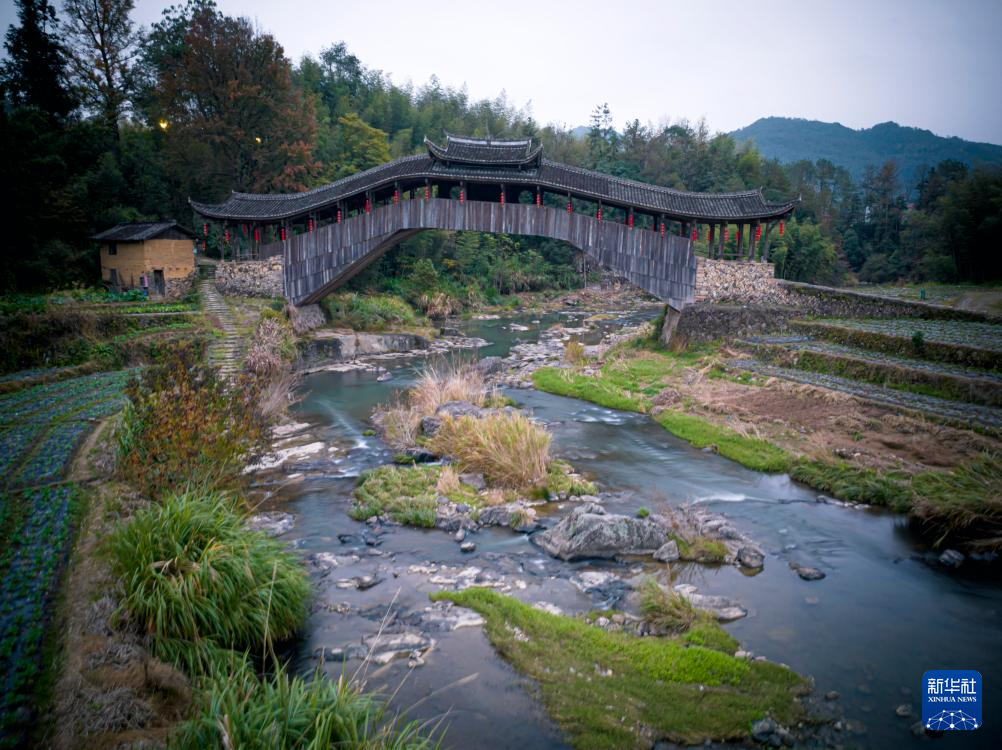




- BRNN
- BRI News
- BRNN News
- Database
Official Documents Polices and Regulations
Inter-government Documents International Cooperation BRI Countries
Business Guide Economic Data BRI Data
Trade
Investment Projects Latest projects
Cases - Content Pool
Zeng Jiakuai is a provincial-level inheritor of the traditional design and practices for building Chinese wooden arch bridges, which were added to the Representative List of Intangible Cultural Heritage of Humanity by the United Nations Educational, Scientific and Cultural Organization (UNESCO) on Dec. 5, 2024, in Taishun county, Wenzhou city, east China's Zhejiang Province.
Known as a hub of wooden arch bridges in China, Taishun county is home to 32 well-preserved ancient wooden arch corridor bridges, including 15 listed as major historical and cultural sites protected at the national level.

The photo taken on Dec. 12, 2024 shows Wenxing Bridge in Taishun county, east China's Zhejiang Province. (Photo/Xinhua)
In recent years, Zeng has led teams to build 20 wooden arch corridor bridges and restore six others.
Born into a family of carpenters in Sixi township, Taishun county, Zeng built a model of Beijian Bridge, a famous ancient wooden arch bridge in the town, using the techniques of mortise and tenon joints when he was 29.
He spent nearly three years meticulously studying ancient corridor bridges in the county, recording data on their different parts and creating detailed models. "Now all the data is digitized, becoming a precious digital asset," Zeng said.
In 2017, Zeng undertook the task of restoring Wenxing Bridge, an ancient wooden arch corridor bridge listed as a major historical and cultural site protected at the national level, after a devastating flood.
"The ancient bridge's asymmetrical structure is unique, seamlessly blending with the surrounding landscape. This made it difficult for us to restore the bridge. Besides, we had to rely on experience to draw up and revise a design as there was no existing one," Zeng said.
This enabled Zeng to gain important experience in restoring wooden arch corridor bridges.
To better pass on the wooden arch corridor bridge construction skills, Zeng often gives lectures at universities and invites students to his studio. "Protection and inheritance must be integrated into contemporary life," he said, adding that building wooden arch corridor bridges contributes to cultural inheritance.
Similarly, Zheng Huiming, 42, is a municipal-level inheritor of the traditional design and practices for building Chinese wooden arch bridges in Shouning county, Ningde city, southeast China's Fujian Province. The county is home to 19 ancient wooden arch corridor bridges.

File photo shows the Shuanglong wooden-roofed arch bridge in Xietan town of Shouning county, Ningde, southeast China's Fujian Province. (China News Service/Gong Jian)
Zheng, who continues a family tradition spanning nine generations, is now participating in the construction of a wooden arch corridor bridge in his hometown of Dongshanlou village in the county - fulfilling a dream passed down through his family. This is the 13th wooden arch corridor bridge he's been involved in building.
Wu Zuming, deputy head of the culture, sports and tourism bureau of Shouning county, said the county has taken various measures to vigorously promote the traditional design and practices for building Chinese wooden arch bridges.
The county's inheritors have built over 20 new wooden arch corridor bridges in the county, constructed seven bridges in other places upon invitation, and participated in the restoration of eight ancient corridor bridges.

Tel:86-10-65363107, 86-10-65368220, 86-10-65363106